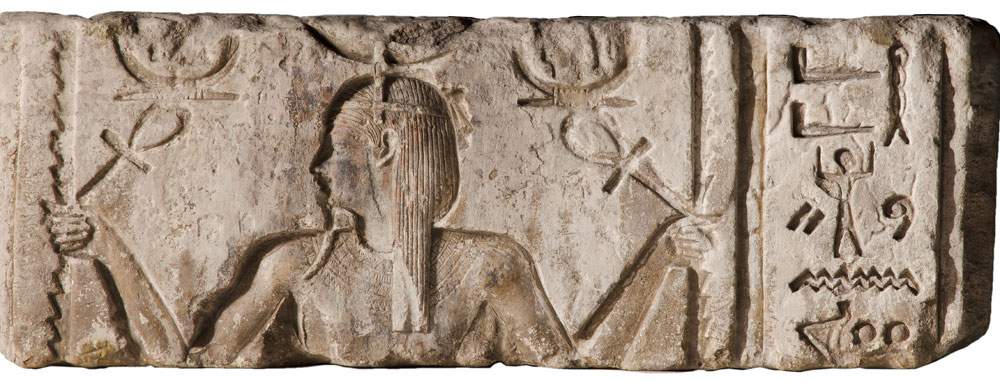Open restoration for ancient Egyptian temple relief with god Heh at Bologna Archaeological Museum
Restoration of a splendid temple relief with an image of the god Heh, most likely datable to the reign of the ruler Ptolemy II Philadelphus (285-246 B.C.), kicks off at the Museo Civico Archeologico di Bologna. The restoration is part of the 19th edition of Restitutions. Restored Treasures of Art, the two-year program of restorations of works of art belonging to the national heritage curated and promoted by Intesa Sanpaolo.
The relief was first displayed to the public at the Museo Civico di Bologna in 1961, on the occasion of the temporary exhibition Ancient Egypt in the Minor Collections of Northern Italy curated by Silvio Curto, then director of the Egyptian Museum in Turin. In 2013, half a century later, the Puppi family, owner of the relief, generously donated it to the museum, bringing it into Bologna’s rich and prestigious Egyptian collection.
Scientifically coordinated by Egyptologist official Daniela Picchi, the project allows the Civic Archaeological Museum to continue and update its research, study and enhancement activities on its historical collections.
The restoration was preceded by a diagnostic imaging campaign, by DI.AR. Diagnostica per immagini per i Beni Culturali, and of microinvasive investigations, by experts from the Opificio delle Pietre Dure in Florence, with which the museum boasts a long-standing collaboration. The results of the investigations made it possible to verify the possible survival of colors, which were certainly present originally, and the characteristics of the patina that partially obscures the limestone.
Performing the restoration will be Cristina del Gallo, an expert restorer of stone materials.
Three open worksite days are planned for this restoration inside the Egyptian Section: on Sept. 8, 15 and 1l 22, the relief and conservation treatments will be closely observed.
The stone relief is from the wall of an as yet unidentified Egyptian templeand shows only part of a larger scene carved in recess. The upper part of the figure of Heh, a deity known since the Old Kingdom, representing the concept of multitude and infinity, is visible. The god wears a broad breastplate, has a curved beard and a wig with thick locks, topped by a kind of solar disk. He faces to the left and raises his arms to shoulder height, holding a renepet (’time’) palm branch in both hands. An ankh (’life’) sign, tilted toward the god’s head, is placed in the junction between the palm branch and the god’s fist to support a cartouche, of which only the lower part remains. The cartouche on the left, although much damaged, allows identification of the last two hieroglyphs of the enthronement name of Ptolemy II Philadelphus (285-246 BCE), the second ruler of the Macedonian-born dynasty that assumed power in Egypt after Alexander the Great.
All the iconigraphic elements of the deity refer to the concepts of time and multitude, life, dominion, and duration. The association with Ptolemy II’s cartouches seems to betray the ruler’s aspiration for a perpetual renewal of power, legitimacy, strength and life, rather than the concept of infinity or infinity of time and space, which nonetheless connote the god.
For info: www.museibologna.it/archeologico
Hours: Until Sept. 14, 2021, Mondays and Wednesdays from 10 a.m. to 1 p.m., Thursdays and Fridays from 3 p.m. to 7 p.m., Saturdays, Sundays, holidays from 10 a.m. to 7 p.m. Closed Tuesdays not holidays. From Sept. 15, 2021, Mondays and Wednesdays from 9 a.m. to 2 p.m., Thursdays from 3 p.m. to 7 p.m., Fridays, Saturdays, Sundays, holidays from 10 a.m. to 7 p.m. Closed Tuesdays not holidays
Tickets: Full € 6 | reduced € 3 | special reduced € 2 young people 18-25 years old | free Culture Card holders
Image: Templar relief with the god Heh (Ptolemaic period (332-31 BC); limestone, 25 x 73 cm; provenance unknown; Bologna, Museo Civico Archeologico. Gift of Giampietro and Bianca Puppi)
 |
| Open restoration for ancient Egyptian temple relief with god Heh at Bologna Archaeological Museum |
Warning: the translation into English of the original Italian article was created using automatic tools. We undertake to review all articles, but we do not guarantee the total absence of inaccuracies in the translation due to the program. You can find the original by clicking on the ITA button. If you find any mistake,please contact us.





























